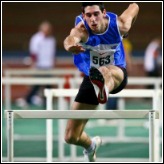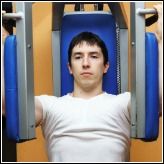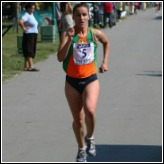What is Plyometrics?
What is plyometrics? Wel the aim of all strength training methods is help you to jump higher or further, to run faster, throw further and lift heavier. To achieve these aims the most important quality you need to have is power.

One of the most effective means of training for power is through
plyometric training. All seasoned athletes know that plyometric training
should be an important part of their workout, but most of them do not
really understand what plyometrics is about. So let me explain...
Plyometrics, or plyos as it is sometime called, is a kind of training which develops explosive strength using natural dynamic movements such as jumping. Most sports need intense energy bursts either throughout the whole activity as in sprinting or intermittently such as in field games. It is not so surprising then, to see that the athletes who train with plyometrics are normally the better sports men and women because they are much more explosive than their counterpart.
While professional and college athletes have been doing plyometric exercises for years, the training method is also getting popular among people who want variety in their workout routine. Simply put, plyometrics is really only another form of strength training.
It offers performance improvement in almost all sports including basketball, boxing, golf, tennis, and football. Even MMA players can improve their attack tactics using plyometric training.
What Is Plyometrics and Why Should I Do It?
Research shows that the powerful and fast movements in plyo training can boost the neuromuscular system because it encourages quick and powerful muscular contractions. It is among the best ways to increase jumping power. This is important for both high jumpers and basketball players. Plyo training also influences your physical durability.
These days, many coaches (even at school level) recognize the importance of plyometric training for their teams. Plyometrics can make a lot of difference in your performance.
How Plyometric Exercises Work?
So now you know what is plyometrics. But how does it work? Well all plyometric activities utilize what is termed – the Stretch Shortening Cycle (SSC).
The Stretch Shortening Cycle can be explained in the following way - in most dynamic movements the muscle is first stretched (eccentrically) before it contracts (concentrically). For example, if you do a dip before a vertical jump, your center of mass will be lowered quickly and in so doing your muscles will be stretched. Any muscle that is stretched prior to a concentric contraction will always contract with more speed and force. This eccentric - concentric coupling is referred to as the SSC.
There are 2 variables, which contribute to the SSC, and although they will be discussed separately, they work together and are intrinsically linked. The models which explain this concept are called: the mechanical model and the neurophysical model.
Mechanical Model
It has been discovered that if a concentric contraction is preceded by a quick eccentric action, the force generated by the concentric contraction is significantly more powerful due to stored elastic energy. During the eccentric phase of the movement the connective tissue surrounding the muscle is stretched, energy is stored, and as the muscle undergoes a concentric contraction, the stored energy is recovered and is used to contribute to the shortening contraction. This is quite like stretching a spring that wants to come back to its position when it is released.
What is Plyometrics - Neurophysical Model
When muscles undergo quick stretches, a protective involuntary response is generated to avoid potential harm to the muscle. This is called a stretch reflex. And it works in the following way - within the muscle complex there are organs called the muscle spindles. The spindle is sensitive to stretch, and is activated during violent stretching of the spindle itself and the surrounding muscle fibers. Upon being activated a signal is sent to the surrounding muscle to contract, thus relieving the stretch on the spindle. The stretch reflex raises muscular activity, thus letting it act with a lot of force.
There are many technical elements involved with plyometric training and if you are still unsure how to apply your new found knowledge, you can consult a good coach or physical trainer.
Sign Up For The Latest Track And Field News And Improve Your Athletic Performance!
From "What Is Plyometrics" Back To "Faster, Stronger, Better – Your Shortcut To Improved Athletic Performance"
Learn more about plyometric training







